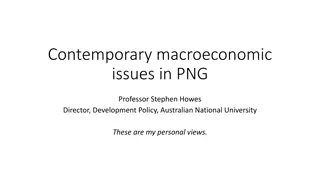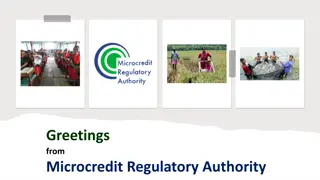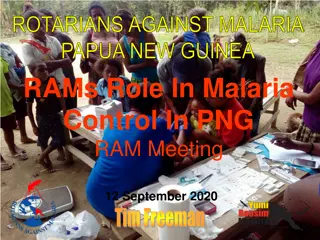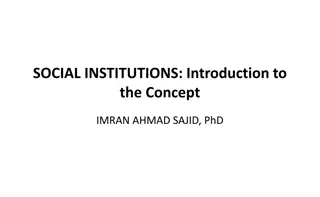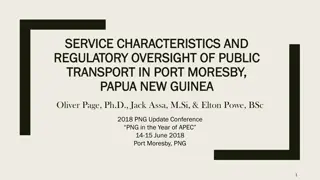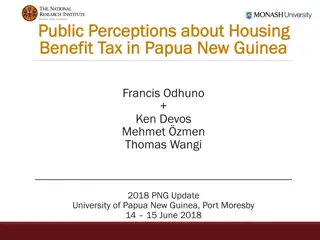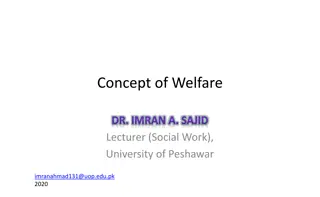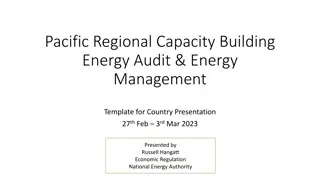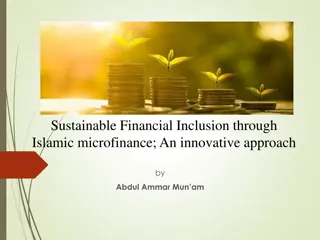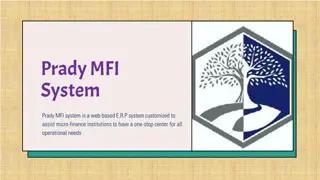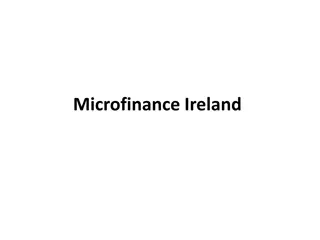Efficiency Analysis of Microfinance Institutions in Papua: A Study by Dr. Muneer Babu
Analysis of the performance and efficiency of Microfinance Institutions in Papua New Guinea, focusing on the provision of financial services to the underbanked population. The study evaluates the resource utilization and efficiency of MFIs, comparing less efficient and highly efficient institutions. Specific objectives include examining efficiency ratios and scale efficiency of MFIs during 2015-17. Input profiles of various MFIs in 2016-17 are also discussed to provide insights into the industry's development process.
Download Presentation

Please find below an Image/Link to download the presentation.
The content on the website is provided AS IS for your information and personal use only. It may not be sold, licensed, or shared on other websites without obtaining consent from the author. Download presentation by click this link. If you encounter any issues during the download, it is possible that the publisher has removed the file from their server.
E N D
Presentation Transcript
Performance of Microfinance Institutions in Papua New Guinea Dr. Muneer Babu M Senior Lecturer in Economics IBSUniversity
Microfinance Microfinance is a provision of small financial services (saving, loan, insurance and remittance) through group lending mechanism even without collateral. This promise to solve some problems (high risk of default, few methods of enforcement of credit contract and cumbersome procedures) of traditional banking mechanism.
Microfinance Access to financial services are important to ensure smoothening of income generation and consumption of people. Performance of MFIs development process of the country. As the performance of MFIs can increase access to the various financial services to a large sections of the population, who are under banked currently. is crucial in the
Motivation There is a need of expanding the provision of financial services to the poor. Therefore, the optimal utilization of resources of microfinance institutions are important to achieve the goal. The firm level efficiency analysis give an insight into the level of resource utilization.
Microfinance Institutions (MFIs) in PNG Major PNG microfinance industry consist of Microbank and Savings and loan society (SLS) . As on 01 October 2017, 10 PNG-MFIs report data to Mix Market,. The data shows that PNG microfinance industry has 213.23 million Kina worth of gross loan portfolio, with 36.86 thousand active borrowers. Similarly, with 387.92 million Kina worth of deposits.
Specific Objectives To examine the level of efficiency of two types of Microfinance Institutions in PNG during 2015 -16 and 2016-17. To estimate technical efficiency ratios and scale efficiency ratios of MFIs in PNG. To make a comparison of less efficient MFIs and highly efficient MFIs.
Input Profile of MFIs during 2016-17 Amount of Deposits (In Million Kina) 14.16 69.03 61.43 59.71 3.54 4.21 30.17 5.32 127.17 13.18 Sl. No. No. of Staff Name of MFIs Kadaporaman Nationwide Microbank People's Microbank PNG Microfinance Women's Microbank Alenkano SLS East New Britain SLS Manus SLS NCSL Niu Ailan SLS 27 166 118 162 23 27 50 9 67 21 1 2 3 4 5 6 7 8 9 10 670 387.92 Total
Output Profile of MFIs during 2016-17 No. of Active Borrowers Gross Loan Portfolio (In Million Kina) Sl. No. Name of MFIS (In 000 ) Kadaporaman Nationwide Microbank People's Microbank PNG Microfinance Women's Microbank Alenkano SLS East New Britain SLS Manus SLS NCSL Niu Ailan SLS Total 1.17 4.2 2.32 3.02 0.32 1.33 2 0.78 18.18 3.54 36.86 2.93 51.95 32.28 41.63 0.8 6.45 15.97 2.12 51.97 7.13 213.23 1 2 3 4 5 6 7 8 9 10
Review of Literature: DEA Bassem (2008) studied Countries. Finding: The size of the MFIs has negative effect on efficiency. Haq et.al (2010) studied 39 MFIs across Africa, Asia, and the Latin America. Finding: NGO MFIs are most efficient. Nadiya and R Ramanan (2011) examined 88 Indian MFIs for 2009. Finding: 14 MFIs are efficient. Muneer Babu and Kulshreshtha (2013) studied 79 Indian MFIs. Finding:14 MFIs have full technical efficiency. 35 MFIs in Mediterranean
Literature Review Continue Muneer Babu and Kulshreshtha (2014) studied 34 Indian MFIs during 2006-07 to 2010-11 Found that Total Factor Productivity has been marginally increased with a decline in technological growth in the microfinance industry. Muneer Babu (2016) has studied 34 Indian MFIs during 2006-07 to 2010-11 Found that technological progress is negatively related ted to rate of inflation and positively related to GDP growth rate.
Data and Methodology Mix Market: Data Set of 10 MFIs in PNG. Data Envelopment Analysis: Charnes, Cooper & Rhodes (CRR) Model (1978) Bankers, Charners & Cooper (BCC) Model (1984) Measurement of Scale Efficiency. Software used: DEAP
MFIs, Exhibit CRS during 2015 and/or 2016
MFIs, Exhibit IRS during 2015 and/or 2016
MFIs, Exhibit DRS during 2015 and 2016
Other Findings and Conclusion Under CRS assumption, during 2015 and 2016, the average technical efficiency of microfinance industry was 86.71% and 91.36%. Under VRS assumption, during 2015 and 2016, the average technical efficiency of microfinance industry was 89.34% and 94.34%. MFIs, which are in IRS still have capacity to increase scale of operation. MFIs are in DRS could focus on exploring economies of scope by transferring excess inputs. Explore scope of decentralization, downsizing and other changes in the organizations.

 undefined
undefined


